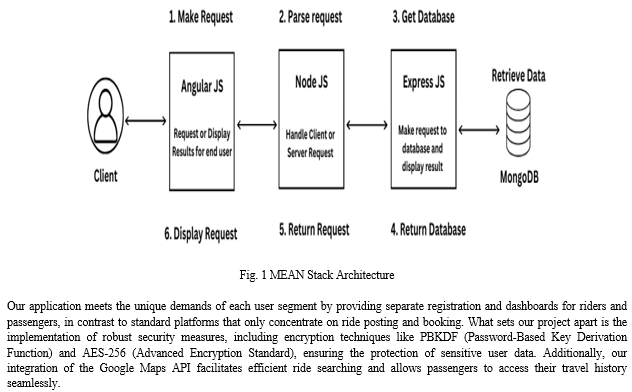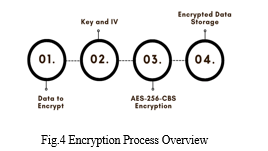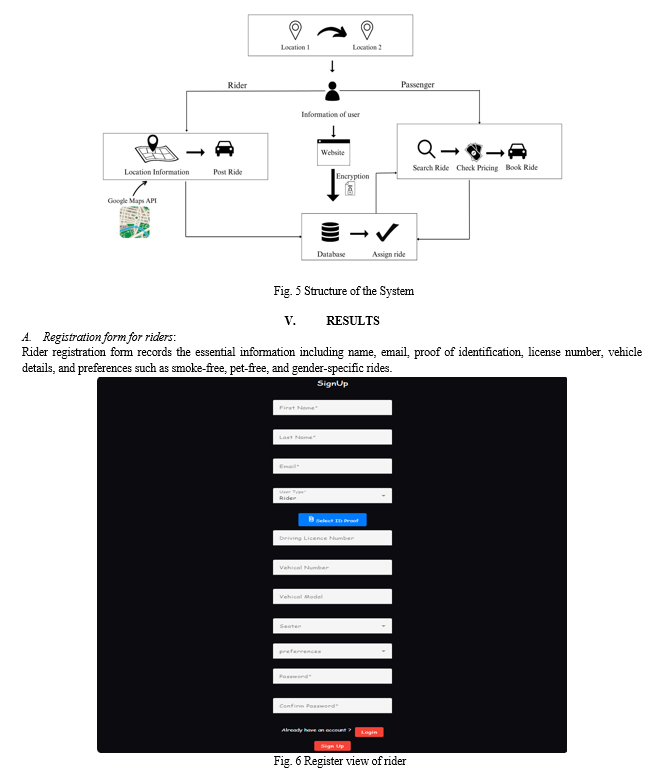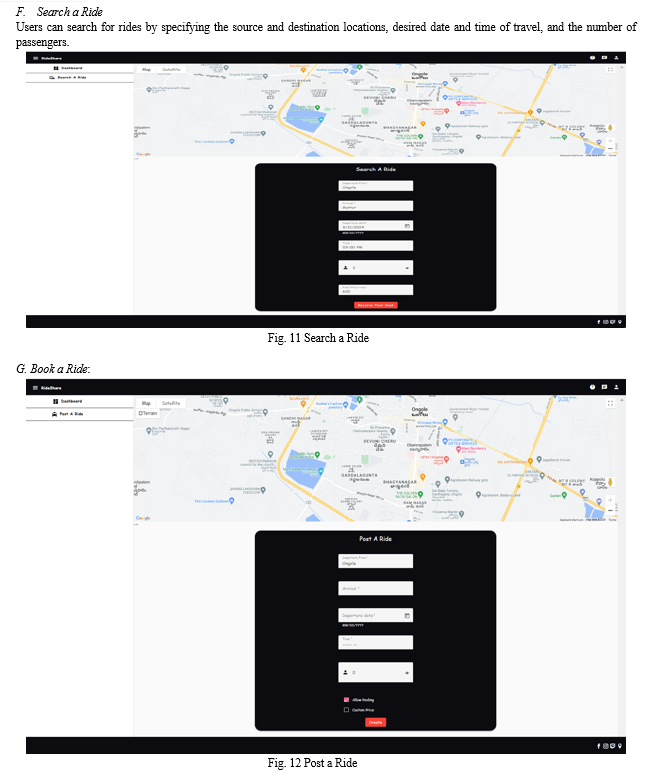Ijraset Journal For Research in Applied Science and Engineering Technology
- Home / Ijraset
- On This Page
- Abstract
- Introduction
- Conclusion
- References
- Copyright
Car Traverse: Simple Solution for Ride Sharing
Authors: B. Lalitha Rajeswari, Talagadadeevi Ajay Krishna, Vasani Sai Chaithrika, Ramavath Anjali Bai
DOI Link: https://doi.org/10.22214/ijraset.2024.59220
Certificate: View Certificate
Abstract
In response to urban transportation challenges like pollution, traffic, and unreliable public transit, our project introduces a user-centric ride-sharing web application using the MEAN stack. By facilitating shared rides with separate dashboards for riders and passengers, we aim to alleviate congestion and provide timely transportation options. Our platform addresses the issue of inaccessibility in public transit, offering commuters a reliable alternative for reaching their destinations on time. Additionally, by promoting carpooling, we contribute to reducing carbon emissions and mitigating environmental impacts. Overall, our project aims to enhance urban mobility, making commuting more accessible, efficient, and sustainable.
Introduction
I. INTRODUCTION
Urbanization has created many problems concerning transport within cities. Such obstacles include traffic jams, air pollution, and insufficient parking lots. Traditional transportation is now not adequate to meet rising mobility needs. This calls for better alternatives to achieve sustainability. Amidst the difficulties at hand, ride-sharing presents a better way of utilizing transport resources optimally through shared rides, thereby reducing cars on the road and preventing more pollution. The objective of this project is to create a web-based ride-sharing application that has all the features that are necessary for urban dwellers who are always on the move. This ride-sharing application aims at revolutionizing how we move in our towns, offering a smooth and environmentally friendly substitute for traditional modes of transport. One way to ensure the environment is protected and vehicles are minimized is through the promotion of shared transport alternatives. Conversely, ride-sharing could lead to a decrease in carbon emissions in urban areas as well as improve accessibility for underprivileged communities through the reduction of time wasted waiting for transportation. Moreover, there could be immense positive economic effects from ride-sharing in the long run. This project seeks to create an online application or service that can be used by citizens who want to share rides towards wider social, economic, and environmental goals rather than simply addressing urgent issues related to urban transportation. Hence Ride sharing has potential for remaking metropolitan transport systems and lifting the living standards of city dwellers through technology-aided collaboration.
II. RELATED WORK
A. Literature Survey
In the paper [1], Piyush Agarwal, Apurva Joshi, Harsh Agarwal, Ajinkya Ghorpade, and Avinash Bagul conducted an extensive survey on peer-to-peer ride-sharing paradigms and associated technologies and their challenges of optimal routing, computation of the shortest path, and communication protocols. The paper also elaborates on a distance estimation method that is based on deep learning and can be used to develop a location-based taxi-hailing application for university students and staff.
In the paper [2], A S M Bakibillah introduced a method for refining the ride sharing procedure, fare creation, and travel planning. It makes smart use of city infrastructure and their data to encourage effective transport and eco-conscious city movement. This new way helps solve problems with transportation in cities. It demonstrates the important role rewards play in mobility solutions that help cities grow in a green way.
In the paper [3], Dejan Dimitrijevic, Nemanja Nedic and Vladimir Dimitrieski presented a real-time carpooling and ride-sharing solution using Web sockets, NoSQL databases, and distributed cloud architecture to make it global. This prototype proves the possibility by providing dynamic, ubiquitous mobility options across all sorts of devices and platforms.
In the paper [4], Rowshonara Akter Akhi explored the differences between Uber and Pathao ride-sharing services by pointing out variations in fare and availability of vehicles using statistical analysis and clients' surveys. The study highlights the socio-economic effects of ride-sharing services in Dhaka city, which can be used as guidelines for other sectors within the industry.
In the paper [5], Tarnovetckaia and Hamid Mostofi conducted a survey to determine how the sharing of cars and pay-for-ride services affected the public transportation system in Moscow. To research how often people use these forms methods, depending on age and location, the authors administered an online mobility survey to Moscow agglomeration residents.
In the paper [6], a tactic used by Hu and his colleagues is the creation of three initial cost-sharing mechanisms that deal with issues of cost allocation between drivers and passengers in a ride-sharing context. These mechanisms, in turn, are extended to account for time windows and include monetary value of time in order to minimize costs for all stakeholders involved.
B. Existing Systems
Most of the existing ride-sharing platforms primarily focus on basic functionalities such as ride posting and booking, overlooking security. These platforms often lack separate registration and tailored dashboards for riders and passengers, failing to address the specific needs of each user segment. Moreover, many existing platforms lack robust security measures, leaving sensitive user data vulnerable to breaches. Additionally, while some platforms offer basic mapping features, they do not seamlessly integrate advanced functionalities like the Google Maps API for efficient ride searching and access to travel history. As a result, users may experience a subpar, generic ride-sharing experience lacking in personalization and security features.
III. METHODOLOGY
Our project will mainly focus on making the ride process simple with the least technology used, keeping in mind that we are dealing with technology novices. This involves the incorporation of only essential features, aimed at enhancing efficiency and convenience for both riders and passengers. To achieve these goals, we will use modern technologies such as MongoDB, Express.js, Angular, and the Node.js (MEAN) stack. The MEAN stack offers a reliable basis for the app’s architecture, which is also scalable. MongoDB serves as a database for storing user data and ride information among other relevant entities, helping in efficient data management and retrieval. Express.js allows for server-side logic implementation, thus smoothly integrating it with front-end interfaces or even external services. Angular powers the front-end interface, hence enabling dynamic user experiences that respond to their needs.



B. Database Design and Management
In our application, MongoDB is the choice of database management system to underpin a ride sharing application, as it’s resilient and versatile. As a document-based architecture, it allows for a structure that fits all the user data, ride details, and preferences about available rides. More importantly, the schema-less design of MongoDB means that updates or changes can be made to the data model so that it remains effective as our application evolves in the future. MongoDB's extensive querying capabilities, along with its powerful indexing features, make it simple to integrate into the Node.js backend.
In the end, a ride-sharing application such as this one should have a database that is more than just a storage tool. The MongoDB solution will help create a system that is high-performance, scalable, and flexible as the needs of its users change.
C. Frontend Implementation: Designing User-friendly Dashboards
Angular facilitated the development of a dynamic and intuitive UI in the front-end building phase of our project for our ride-sharing application. Using Angular’s rich features, we made separate dashboards for both riders and passengers. Not only can riders post rides effortlessly, but they can also look into their ride history and upcoming trips, as well as the money earned so far. At the same time, an easy-to-use search function is available to help passengers quickly find rides that fit their preferences or needs. This consequently allowed us to create a user experience that is responsive and thus enhances users’ participation as well as gratification, owing to Angular’s modular architecture and powerful template mechanisms.
D. Azure for Version Control
The role of Azure DevOps in our project was fundamental to the seamless collaboration and version control that occurred. This helped us manage our code base well by using its features like repository hosting for codes, branching features, and pull requests. It therefore reduced downtime, leading to increased productivity, as it let us commit changes easily and fetch updates without any difficulty or conflicts during the software development process. Although our use of this service involved mainly basic version control tasks, it is a good starting point for team coding exercises since it has an intuitive interface and powerful capabilities, which eventually helped us achieve success with our project.
E. AWS for Deployment
For hosting our ride-sharing web application, we used AWS as our deployment platform. For our app to be deployed reliably and on a large scale, we made use of AWS’s infrastructure. This option enabled our application to have smooth deployment flows and provided a strong host environment. We aimed at using AWS for high availability and performance for users with minimal operational overheads.
F. Google Maps API Integration
In our project, we smoothly incorporated the Google Maps API to improve the user experience with interactive mapping. It means that users can enter their starting point and destination easily, and the API then creates dynamic routes on the interface of a map. This feature not only helps visualize routes but also allows planning travel in a better way. Moreover, with the support of the Google Maps API, there is a possibility to convert addresses into geographical coordinates for accurate mapping, referred to as geocoding services. Our ride-sharing web application has been made more usable and satisfying to its users by taking advantage of the Google Maps API’s capabilities and integrating it with our platform through an intuitive design that focuses on the visualization of interesting destinations.




VI. LIMITATIONS
- For ride-sharing to become popular, there is a need for focused marketing as well as efforts geared toward urging people to use this service.
- Longer wait times for rides can occur due to variations in the number of riders.
- The application's inaccessibility to non-native speakers or any person from a different linguistic background because of its unavailability in more than one language.
- Disabled users may have difficulty entering and utilizing the application because it does not provide enough aid for keen, hearing-impaired, or physically disabled individuals.
- Users' hesitation towards sharing personal data may impact app usage.
VII. FUTURE WORK
The application can be developed further in the future, with an emphasis on incorporating cutting-edge technologies like blockchain, artificial intelligence, and machine learning to improve ride-sharing services' effectiveness, user experience, and safety. This might entail creating machine learning algorithms to customize user experiences, using blockchain for safe and transparent transactions, and creating predictive analytics algorithms to optimize truck routing. Furthermore, adding delivery choices, bike and scooter sharing, and other services might improve mobility and sustainability initiatives. Positive community connections and the project's credibility can be further enhanced by working with neighbourhood organizations and sponsoring social projects. Furthermore, to guarantee user happiness and inclusivity, ongoing improvements to the user interface and accessibility features will be essential.
Conclusion
In conclusion, our ride-sharing web application is not only helping to curb traffic but also playing a role in the direction of eco-friendly responsibility and economic prosperity. Our platform reduces congestion on roads and carbon emissions by soaking cars together and encouraging carpooling, thereby sustaining our environment. Additionally, sharing rides creates a sense of community and lowers transportation expenses. This has individual advantages as well as increasing professional incomes that promote local businesses. The purpose of this project is to embolden a sustainable and accountable movement system among users for mutual benefit between them and others in their society at large.
References
[1] Piyush Agrawal, Harsh Agrawal, Avinash Bagul, Apurva Joshi and Ajinkya Ghorpade, “Survey on peer-to-peer ride-sharing for “pool” a ride sharing app” , International Journal of Engineering Applied Sciences and Technology(IJEAST), Vol. 5, Issue 8, December 2020. [2] A S M Bakibillah, Yi Feng Paw, M.A.S. Kamal, Susilawati Susilawati, Chee Pin Tan, “An Incentive Based Dynamic Ride-Sharing System for Smart Cities” , Smart Cities, Vol. 4, Issue 2, April 2021. [3] Dejan Dimitrijevi?, Nemanja Nedi?, Vladimir Dimitrieski, “Real-Time Carpooling and Ride-Sharing: Position Paper on Design Concepts, Distribution and Cloud Computing Strategies” , In Preprints of the Federated Conference on Computer Science and Information Systems (pp. 801–806), September 2013. [4] Rowshonara Akter Akhi, “Comparative Analysis between Ride-Sharing Services: An Empirical Study from Emerging Market” , Journal of Business Analytics and Data Visualization, Vol. 2, Issue 1, April 2021. [5] Rozaliia Tarnovetckaia and Hamid Mostofi, “Impact of Car-Sharing and Ridesourcing on Public Transport Use: Attitudes, Preferences, and Future Intentions Regarding Sustainable Urban Mobility in the Post-Soviet City” , Urban Sci, Vol. 6, May 2022. [6] Shichun Hu, Maged M. Dessouky, Nelson A. Uhan and Phebe Vayanos, “Cost-sharing mechanism design for ride-sharing”, Transportation Research Part B: Methodological, Vol. 150, 410-434, ISSN 0191-2615, August 2021. [7] Qingyuan Li, Hao Wu and Chen Dong, “A Privacy-Preserving Ride Matching Scheme for Ride Sharing Services in a Hot Spot Area”, Electronics, Vol. 12, Issue 4, August 2021. [8] Alejandro Lugo, Nathalie Aquino, Magalí González, Luca Cernuzzi and Ronald Chenu-Abente , “Ucarpooling: Decongesting Traffic through Carpooling using Automatic Pairings” , 2020 XLVI Latin American Computing Conference (CLEI), Vol. 23, Issue 4, June 2021. [9] Daniel Oviedo Hernandez, D Perez Jaramillo and Mariajose Nieto, “Governance and Regulation of Ride-hailing Services in Emerging Markets: Challenges, Experiences and Implications”, IDB Technical Note, 2164. Inter-American Development Bank, August 2021. [10] Negin Alisoltani, Ludovic Leclercq and Mahdi Zargayoung, “Can dynamic ride-sharing reduce traffic congestion?” , Transportation Research Part B: Methodological, Vol. 145, 212-246, ISSN 0191-2615, February 2021.
Copyright
Copyright © 2024 B. Lalitha Rajeswari, Talagadadeevi Ajay Krishna, Vasani Sai Chaithrika, Ramavath Anjali Bai. This is an open access article distributed under the Creative Commons Attribution License, which permits unrestricted use, distribution, and reproduction in any medium, provided the original work is properly cited.

Download Paper
Paper Id : IJRASET59220
Publish Date : 2024-03-20
ISSN : 2321-9653
Publisher Name : IJRASET
DOI Link : Click Here
 Submit Paper Online
Submit Paper Online

